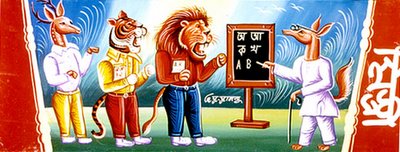 From touristy scenes of the Taj Mahal to images of Saddam Hussein and Osama bin Laden to schmaltzy depictions of movie stars, the art that covers Bangladesh's foot taxis, or rickshas, runs the gamut. But as anthropologist Joanna Kirkpatrick reports, these elaborately painted vehicles don't have counterparts in nearby Hindu India or Buddhist Sri Lanka. Why?
From touristy scenes of the Taj Mahal to images of Saddam Hussein and Osama bin Laden to schmaltzy depictions of movie stars, the art that covers Bangladesh's foot taxis, or rickshas, runs the gamut. But as anthropologist Joanna Kirkpatrick reports, these elaborately painted vehicles don't have counterparts in nearby Hindu India or Buddhist Sri Lanka. Why?Perhaps the over-the-top flamboyance of the country's ricksha art is a sign of the "return of the repressed." This is a psychological state that, in the case of art, is based on the human longing to see desired objects and figuratively to possess them. The act of looking at figurative pictures is symbolic appropriation, but it is also experienced as sin because it is condemned by ultra-pious religious authorities: a repression based not on the Koran but on hadith literature. Popular conveyance arts are, therefore, a visual means to openly express officially condemned desires by members of a social class that tends to be ignored, thus opening up the public space for their recognition.To learn more than you ever wanted to know about ricksha art read Kirkpatrick's essay in Persimmon or visit her Ricksha.org.
 (Via Metafilter.)
(Via Metafilter.)While I'm at it: Chewing gum art?
1 comment:
In Vietnam, there isn't enough surface space in cyclos to display art unlike the tuk-tuks in Thailand (or Jeepnies in Manila) which are amazing exhibitions on wheels. Thanks for the post. I has me now thinking of new projects. -RST
Post a Comment